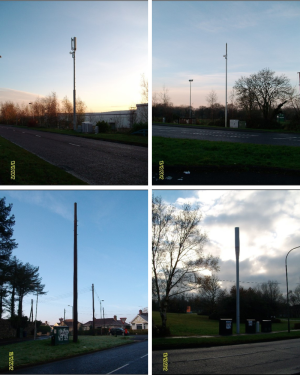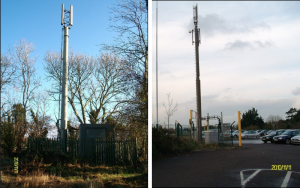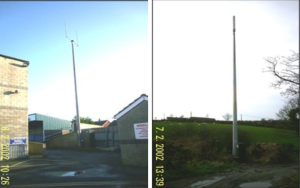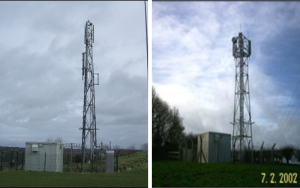Telecommunications Mast (Non Domestic Valuation practice notes)
These Practice Notes were developed for the purpose of revaluing non domestic property in Northern Ireland as part of Reval2023. They were produced primarily as guidance for LPS Valuers to ensure, amongst other things, consistency of approach and practice in rating valuations.
Scope
The scope of this Practice Note is solely to ensure a consistent valuation approach for this property Class / Subclass / Type for Non-Domestic Revaluation 2023 and subsequent entry in the new Valuation List which becomes effective on 1st April 2023.
The basis of valuation for new entries in the Valuation List, and Rating Revision cases after 1st April 2023, is Schedule 12 (2)(1) of the Rates (NI) Order 1977.
Description
This Practice Note refers to property classified as:
Class: Telecommunications
Sub Class: Communications Station
Type: Telecommunications Mast
The most common uses of these hereditaments are:
- Mobile telecommunications networks.
- Transmission of television signals.
- Transmission of radio signals.
- Wireless broadband networks.
It is important to note that those masts, towers, buildings etc linked to the main operational systems of Northern Ireland Water (NIW), Power NI, BT, Mercury and Virgin are not valued as separate hereditaments but are part of the cumulo entries for those bodies.
The principal occupiers of telecommunications sites in Northern Ireland are the mobile telephone operators. There are four main operators:
- EE (Everything Everywhere Ltd)
- Vodafone Ltd
- O2 (Telefonica UK Ltd)
- 3 (Hutchison 3G UK Ltd)
There is an ongoing programme of network consolidation across the UK. In 2010 Orange and T-Mobile started to merge their operations with the establishment of Everything Everywhere Ltd trading as ‘EE’ to deliver the new 4G network. This merger resulted in the sharing of hardware and infrastructure and many sites became obsolete and were decommissioned from operational use. Mobile Broadband Network Ltd (MBNL) was also established as a joint venture between EE and 3 with the aim of sharing infrastructure to provide savings. In 2012 Vodafone and O2 came together with the creation of Cornerstone Telecommunication Infrastructure Ltd (CITL) which had the objective of rolling out a single set of infrastructure for both operators using RAN (Random Access Network) technology. The effect of the latter has been to leave one rateable occupier on the site rather than the previous two operators.
MBNL and CTIL are managing companies that acquire and project manage the sites but they are not in rateable occupation. The rateable occupation will remain with the primary network operator.
There are also sites in the use and occupation of the Northern Ireland Policing Board, Northern Ireland Fire & Rescue Service, Northern Ireland Ambulance Service, Civil Aviation Authority, Met Office, Government Departments, and a range of organisations linked to the transport and traffic sectors.
NIW has a network of masts in connection with its telemetry operations. Most are part of the cumulo entry for NIW but valuers should be aware that many masts are leased to the telecommunication companies for the operation of mobile phones. If NIW retains transmission equipment on a mast then it will be included in the cumulo entry. A site sharer assessment will be entered in the Valuation List for each sharer. Where NIW does not use the mast for operational purposes, valuers must take note of the legislative amendment for shared masts (Appendix 2).
Some sites used by telecommunication companies may be in the rateable occupation of separate companies not themselves involved in the operation of the networks. For example, Arqiva provides sites and related infrastructure to the companies actually operating the networks or broadcasting the signals. Arqiva initially acquired the NTL site portfolio that had previously been the IBA television and radio transmission sites. In 2008 Arqiva then took over National Grid Wireless which owned the Crown Castle site network including the former BBC transmission sites.
Recent years has seen the emergence of companies, such as Bluebox and Air Fibre, which offer a broadband service based on wireless communication; mainly but not exclusively geared to providing improved service to rural areas. The broadband network is based on masts and structures that support microwave wireless transmitters and receivers. The broadband companies may have acquired existing infrastructure; for example, Bluebox operate on a number of former Arqiva sites that had been decommissioned from the mobile phone sector.
The New Electronic Communications Code
The Electronic Communications Code was implemented in 1984 to give telecom operators a statutory basis to install and maintain equipment. In response to industry demands, a new Code was introduced under the Digital Economy Act which was came into force on 28 December 2017. This introduced a number of reforms that aim to assist the operators in developing and improving their networks. The measures included relaxed planning obligations, improved security of tenure, more powers in relation to additional apparatus and assigning interests to other parties.
Legislative Background
Schedule 12 Part 1 Paragraph 1 of the Rates (NI) Order 1977 applies.
“Subject to the provisions of this Order, the Net Annual Value of a hereditament shall be the rent for which, one year with another, the hereditament might, in its actual state, be reasonably expected to let from year to year, the probable average annual costs of repairs, insurance and other expenses (if any) necessary to maintain the hereditament in its actual state, and all rates, taxes or public charges (if any), being paid by the tenant”.
The regulations governing the rateability of Plant and Machinery are found in Part III of Schedule 12 of the Rates (NI) Order 1977, updated by the Valuation for Rating (Plant and Machinery) Order (NI) 1997.
The following items are rateable under Class 3.
(e) cables, fibres, wires and conductors, or any system of such items, or any part of such items or such system, used or intended to be used in connection with the transmission of telecommunication signals, and which are comprised in the equipment of and are situated within premises.
In this paragraph:
“premises” means any hereditament which is used, or intended to be used, mainly or exclusively for the processing or the transmission of communications signals excluding any part of such a hereditament within which there is equipment used mainly for the processing of communication signals;
“processing of communication signals” means the conversion of one form of communications signal to another from or the routing of communications signals by switching; and
“equipment used mainly for the processing of communications signals” includes:
- that part of any associated cable, fibre, wire or conductor which extends from the point of conversion or switching to the first distribution or termination frame or junction; and
- that part of any associated cable, fibre, wire or conductor which extends from the last distribution or termination frame or junction to the point of conversion or switching;
(f) poles, posts, towers, masts, mast radiators, pipes, ducts and conduits, and any associated supports and foundations, used or intended to be used in connection with any of the items included within Paragraph (e).
Under Class 4, Table 3, masts (including guy ropes) and towers for radio or communications signals are named items. To be rateable within Class 4 Table 3 the mast or tower must be a structure or in the nature of a structure.
The following items of plant and machinery are non-rateable:
a. Aerials and microwave dishes, unless they are mast radiators.
b. Under Class 3 any cables, fibres etc within the buildings used to process the signals.
c. The general bulk of the transmissions and switching equipment, distribution frames and air conditioning or cooling equipment which is mainly used to cool the non-rateable equipment.
The Valuation (Telecommunications, Natural Gas and Water) (Amendment)
Regulations (NI) 2015 took effect on 1 April 2015 and provided for the aggregation of all site sharers into a single hereditament with the primary site operator (the host) being responsible for rates.
Valuation approach for 2023
The valuation will comprise a site rental value with an addition, where appropriate, for rateable plant and machinery and buildings. The addition for buildings and plant and machinery is carried out on a shorthand Contractor’s basis using the standard Decapitalisation rate at 3.4%.
Some of the larger established sites with conventional offices and workshops, and some roof top sites with rooms within associated buildings may lend themselves to rental valuations. It is a decision for valuers, but the majority of these larger sites will be assessed by the Contractor’s Basis.
Existing buildings or rooms may already be included in the site rent, particularly with roof top sites.
Site Rents
Site values vary according to the characteristics and location of the site. Higher than average rental values may be associated with prime urban locations, excellent geographical terrain, sites which are in specific demand location by an operator and locations where public opposition is strong. Lower site values can relate to remote rural locations, areas with a plentiful supply of potential sites and sites that do not allow for sharing facilities.
Roof top sites tend to attract higher rents than ground level sites due to generally superior locations and lower installation costs.
Rents for broadband sites are typically lower than for the other transmission sites.
The Practice Note author has conducted analysis of site rents for all areas and provided guidance under each of the Beacon Mast Types in Appendix 1.
Obsolescence and Superfluity
Based on research by the Practice Note author on this class of property superfluity is applied at revaluation.
Obsolescence and superfluity are likely to arise at the older mast sites which were designed to take heavier aerials and have more extensive buildings. Changes in technology have rendered many of the larger buildings to some extent functionally obsolete. A superfluity allowance may be applied to reflect the actual use of the buildings.
Claims for obsolescence and superfluity require rigorous scrutiny. There may be a demand for surplus space from actual or potential users of the mast in the form of site sharers.
Shared Mast Sites
It had been standard practice to enhance the base site rent for each additional operator on the mast. Due to the new Code arrangements it is proposed to make no uplifts for site sharing.
On sites where the mast is in use for cumulo purposes (e.g. NIW) all additional operators on the mast will continue to be valued separately as site sharers.
Appendix 2 provides more detailed guidance on shared sites.
Rent and lease questionnaire
Rent and Lease Questionnaires (RALQs) were not issued. The Practice Note author requested and analysed Rental Schedules from all operators in the market.
Contacts
For advice on any aspect of this Practice Note contact LPS on 0300 200 7801.
Appendix 1 Beacon mast types
Beacon Type 1: Street Pole

Light duty poles similar in construction to streetlamp posts with a base diameter not exceeding 0.4 metre, and heights usually in the range of 10-15 metres with the aerial concealed in a small tube at the top of the pole. These are generally microcell sites installed on public highway verges or pavements with an equipment cabinet at the side.
All street pole sites in Northern Ireland are to be valued at a site value of £2,250 and a total decapitalised cost of £300 giving a rateable value of £2,550.
Beacon Type 2: Ground Level Pole & Column Masts

Self-supporting metal poles and columns are used mainly by the mobile phone operators. Most are medium duty columns and have a base diameter of 0.35 – 0.50 metre and may taper towards the top. The majority are less than 20 metres in height, most commonly in the range of 12-15 metres high. Some columns may have a head frame for aerials and ladders or climbing pegs included. They tend to be sited in standard compounds with equipment cabins.
The costs reflect the standard rates in the spreadsheet applied for medium duty columns and light duty lattice towers. As well as the cost of the mast structure, additions have been made for site preparation, equipment cabin, cabling, cable tray, fencing and gates. Uplifts for contract size and fees and decapitalisation at 3.4%. If the mast is serviced by an equipment cabinet rather than a cabin, the costs are reduced by £250.
Site Rental Values
Greater Belfast Metropolitan Area (GBMA) | £3500 |
Urban | £3000 |
Rural | £3000 |
Greater Belfast Prime | £4500 |
Urban Prime | £4000 |
Rural Prime | £4000 |
GBMA includes Belfast, Castlereagh, Carryduff, Lisburn, Holywood, Bangor, Newtownards, Newtownabbey, Carrickfergus.
Urban includes all other towns, larger villages, main routes and junctions. If valuers are in doubt on location then value at the lower level.
Costs
12m high | £1,350 | Deduct £250 for no cabin |
15m high | £1,450 | |
20m high | £1,700 | |
25m high | £2,050 |
Older Column Mast Sites

There may be a small number of older pole masts which were generally narrower in diameter and have no compound, with probably only a base cabinet rather than a cabin to process the signals. Most of these sites have probably been superseded by updated equipment. Valuers may consult with the specialist district for advice in such cases.
Beacon Type 3: Ground Level Lattice Masts

Lattice masts are generally constructed from angle iron or tubular steel braced sections secured to a square or tripod base. Triangular or circular headframes supporting sector arrays of aerials and microwave dishes are common as are rest platforms and safety ladders. If the mast is serviced by an equipment cabinet rather than a cabin, the costs are reduced by £250.
Site Rental Values
Greater Belfast Metropolitan Area (GBMA) | £3500 |
Urban | £3000 |
Rural | £3000 |
Greater Belfast Prime | £4500 |
Urban Prime | £4000 |
Rural Prime | £4000 |
GBMA includes Belfast, Castlereagh, Carryduff, Lisburn, Holywood, Bangor, Newtownards, Newtownabbey, and Carrickfergus.
Urban includes all other towns, larger villages, main routes and junctions. If valuers are in any doubt on location, value at the lower level.
Costs
15m high | £1,900 | Deduct £250 if no cabin |
20m high | £2,250 | |
25m high | £2,600 | |
30m high | £3,000 | |
35m high | £3,450 | |
40m high | £4,000 | |
45m high | £4,500 | |
50m high | £5,000 |
Beacon Type 4: Roof Top Sites
Roof top sites will include typical stub masts up to 5.0 metres in height, poles, supporting aerials and microwave dishes around the roof perimeter along with safety rails, ladders and platforms. There may be an equipment cabin or a room within the building for use in connection with the mast. In some instances, the equipment may be minimal and not warrant any uplift on the basic site rent value.
Antennae attached to chimneys, silos or floodlights at sports grounds are to be valued as roof top sites.
Site Rental Values
Belfast City Centre | £7500 |
Remainder of Belfast City & all NIHE tower blocks | £6500 |
Greater Belfast Metropolitan Area (as before and excluding Belfast City) | £6000 |
Remainder of Northern Ireland | £5000 |
Costs
Total decapitalised costs for a single cell rooftop installation £1,600. This cost includes an equipment cabin.
If the mast site is served by a cabinet, then the cost should be reduced by £250 to a sum of £1,350.
Broadband Site Rental Values
All street pole sites used for wireless broadband to be valued at a site value of £650 and a total decapitalised cost of £300 giving a rateable value of £950.
Remaining broadband sites to use the following site rental values.
Rural | £1000 |
Urban | £1000 |
GBMA | £1500 |
Rooftop (Belfast) | £1500 |
Rooftop (Remainder) | £1000 |
A large proportion of broadband masts use decommissioned mobile phone mast sites. Valuers are advised to apply similar costs as previously indicated for column and lattice masts. If the mast structure is more basic in character (for example a wooden pole) an allowance may be applied to the rateable value (make in allowance box).
Appendix 2 Sharer Costs
Where a site sharer is to be valued the rateable liability is restricted to the value of the cables, plus any separate buildings or cabins in the site sharer’s occupation. No element of site rent is included in the site sharer’s assessment.
On shared mast sites the following amounts are added to the main host costs in assessing the NAV of the property. On cumulo sites where the only entry will be the site sharer then the amounts below will be entered into the list as the NAV of the operator.
Up to 20m high: NAV £800 (with cabin) £550 (with cabinet)
Over 20m high: NAV £900 (with cabin) £650 (with cabinet)
Key Sites
Valuers can depart from the schedule of prices with an option of increasing the site rental value or costs if it is believed that the site offers advantages above the norm.
Larger Masts
Some masts will be of heavier duty pylon tower construction with more detailed bracing sections and additional platforms and ladders. There may be secondary support masts and guy wires leading to extra support foundations. Such masts will require individual analysis and assessment and, in the case of more established sites, may involve the application of obsolescence and superfluity allowances.
The Reval 2023 LPS Cost Guide provides details on mast costs, common items, contract size adjustment and fees. Generally the mast costs include the concrete base and foundation. Additions will be required for buildings, cabins, cabling and trays, fencing and gates, and site preparation and improvements.
All costs for larger mast sites have been adjusted for Northern Ireland use.
Finally the contract size adjustment and addition for fees is applied prior to decapitalisation at 3.4%.
Site Rental Values for Larger Masts
The evidence for site rents is based primarily on the smaller mast sites used by the mobile phone operators. Larger masts of similar construction and base width should be valued at similar rental levels.
The more established broadcasting sites formerly occupied by the BBC and IBA tend to be much larger and valuers must exercise discretion as to appropriate values for specific locations.